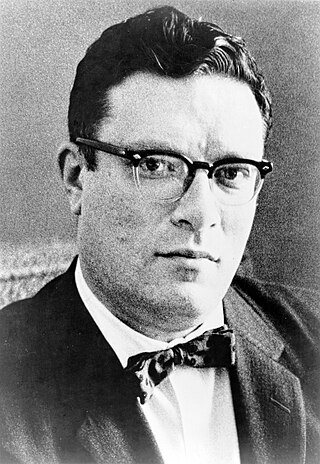
Isaac Asimov was an American writer and professor of biochemistry at Boston University. During his lifetime, Asimov was considered one of the "Big Three" science fiction writers, along with Robert A. Heinlein and Arthur C. Clarke. A prolific writer, he wrote or edited more than 500 books. He also wrote an estimated 90,000 letters and postcards. Best known for his hard science fiction, Asimov also wrote mysteries and fantasy, as well as popular science and other non-fiction.
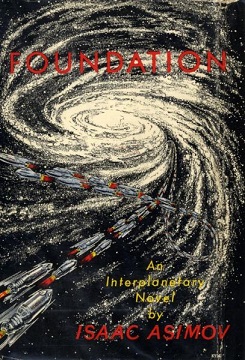
The Foundation series is a science fiction book series written by American author Isaac Asimov. First published as a series of short stories and novellas in 1942–50, and subsequently in three books in 1951–53, for nearly thirty years the series was widely known as The Foundation Trilogy: Foundation (1951), Foundation and Empire (1952), and Second Foundation (1953). It won the one-time Hugo Award for "Best All-Time Series" in 1966. Asimov later added new volumes, with two sequels, Foundation's Edge (1982) and Foundation and Earth (1986), and two prequels, Prelude to Foundation (1988) and Forward the Foundation (1993).
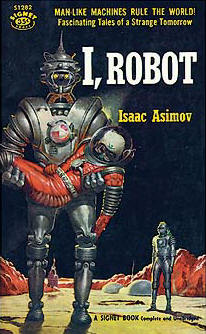
The Three Laws of Robotics are a set of rules devised by science fiction author Isaac Asimov, which were to be followed by robots in several of his stories. The rules were introduced in his 1942 short story "Runaround", although similar restrictions had been implied in earlier stories.
Thiotimoline is a fictitious chemical compound conceived by American biochemist and science fiction author Isaac Asimov. It was first described in a spoof scientific paper titled "The Endochronic Properties of Resublimated Thiotimoline" in 1948. The major peculiarity of the chemical is its "endochronicity": it starts dissolving before it makes contact with water.

Foundation is a science fiction novel by American writer Isaac Asimov. It is the first book in the Foundation Trilogy. Foundation is a cycle of five interrelated short stories, first published as a single book by Gnome Press in 1951. Collectively they tell the early story of the Foundation, an institute founded by psychohistorian Hari Seldon to preserve the best of galactic civilization after the collapse of the Galactic Empire.

"C-Chute" is a science fiction short story by American writer Isaac Asimov. It was first published in the October 1951 issue of Galaxy Magazine and later appeared in Asimov's collections Nightfall and Other Stories (1969) and The Best of Isaac Asimov (1973).

Buy Jupiter and Other Stories is a 1975 collection of short stories by American writer Isaac Asimov. Each story is introduced by a short account of how it came to be written and what was happening in Asimov's life at the time, and follows on from where The Early Asimov (1972) left off. In the introduction, Asimov explains that his objective is to tell enough of his autobiography in his short story collections so that his editors will stop asking him to write an actual autobiography.
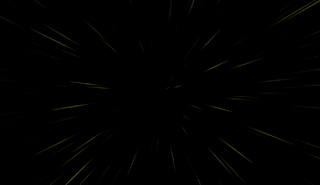
In science fiction, hyperspace is a concept relating to higher dimensions as well as parallel universes and a faster-than-light (FTL) method of interstellar travel. In its original meaning, the term hyperspace was simply a synonym for higher-dimensional space. This usage was most common in 19th-century textbooks and is still occasionally found in academic and popular science texts, for example, Hyperspace (1994). Its science fiction usage originated in the magazine Amazing Stories Quarterly in 1931 and within several decades it became one of the most popular tropes of science fiction, popularized by its use in the works of authors such as Isaac Asimov and E. C. Tubb, and media franchises such as Star Wars.
"Shah Guido G." is a science fiction short story by American writer Isaac Asimov. It was first published in the November 1951 issue of Marvel Science Fiction and reprinted in the 1975 collection Buy Jupiter and Other Stories, where Asimov explains his love of puns. It is an example of a shaggy dog story, as indicated by the title.
"Not Final!" is a science fiction short story by American writer Isaac Asimov, originally published in the October 1941 issue of Astounding Science Fiction, and included in the 1972 collection The Early Asimov. Its sequel, "Victory Unintentional", is a robot story. These are two of the few stories by Asimov to postulate non-human intelligences in the Solar system.
"Buy Jupiter!" is a humorous science fiction short story by American writer Isaac Asimov. It was first published in the May 1958 issue of Venture Science Fiction Magazine, and reprinted in the 1975 collection Buy Jupiter and Other Stories. The original title of the story was "It Pays," though it was never published under this name.

"Founding Father" is a science fiction short story by American writer Isaac Asimov. It was first published in the October 1965 issue of Galaxy Science Fiction, and reprinted in the 1975 collection Buy Jupiter and Other Stories. It was inspired by a cover painting of a space-helmeted face backed by several crosses, provided by the magazine's editor, Frederik Pohl.
"Light Verse" is a science fiction short story by American writer Isaac Asimov. It was first published in the September–October 1973 issue of The Saturday Evening Post. It later appeared in the collections Buy Jupiter and Other Stories (1975), The Complete Robot (1982), and Robot Dreams (1986). The author has reported that he wrote the initial draft in one session and later had to change hardly a word in the final revision.
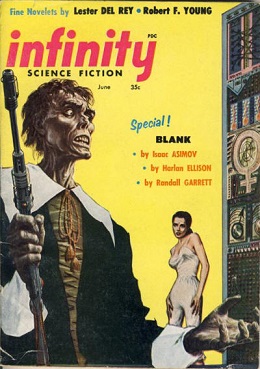
"Blank!" is a science fiction short story by American writer Isaac Asimov. It was commissioned by Larry Shaw, editor of Infinity Science Fiction, as being the least inspirational title on which to base a story. Harlan Ellison and Randall Garrett were also invited to submit stories based on the same title; Garrett wrote one with "Blank?" as the title while Ellison submitted "Blank." All three were published in the magazine in June 1957. Asimov's story was later reprinted in the 1975 collection Buy Jupiter and Other Stories.
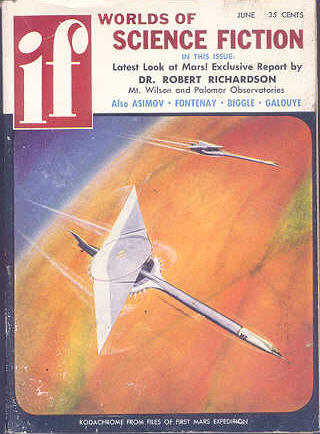
"Does a Bee Care?" is a science fiction short story by American writer Isaac Asimov. It was first published in If: Worlds of Science Fiction in June 1957, and reprinted in the 1975 collection Buy Jupiter and Other Stories. Gold Key Comics also published a comic book version of the story in 1976 in #4 of the four issue science fiction series Starstream: Adventures in Science Fiction. It also appeared in 1976's Questar: Illustrated Science Fiction Classics, published by Golden Press and adapted by A. Moniz with artwork from Jack Abel and in 1975 in Buy Jupiter and Other Stories.
"Exile to Hell" is a science fiction short story by American writer Isaac Asimov. It appeared in the May 1968 issue of Analog Science Fiction and Fact and was included in the 1975 collection Buy Jupiter and Other Stories.
"2430 A.D." is a science fiction short story by the American writer Isaac Asimov. It first appeared in the October 1970 issue of Think, the IBM house magazine, and was reprinted in Asimov's 1975 collection Buy Jupiter and Other Stories.
"The Greatest Asset" is a science fiction short story by American writer Isaac Asimov. It was written as a counterpoint to his story "2430 A.D." with the intention of refuting, rather than illustrating, the same quotation by writer and social commentator J. B. Priestley from his 1957 book Thoughts in the Wilderness. It was published in the January 1972 issue of Analog and reprinted in the 1975 collection Buy Jupiter and Other Stories.
Isaac Asimov wrote three volumes of autobiography. In Memory Yet Green (1979) and In Joy Still Felt (1980) were a two-volume work, covering his life up to 1978. The third volume, I. Asimov: A Memoir (1994), published after his death, was not a sequel but a new work which covered his whole life. This third book won a Hugo Award.

Space travel, or space flight is a science fiction theme that has captivated the public and is almost archetypal for science fiction. Space travel, interplanetary or interstellar, is usually performed in space ships, and spacecraft propulsion in various works ranges from the scientifically plausible to the totally fictitious.









